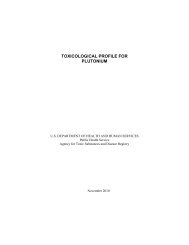BMC Evolutionary Biology
BMC Evolutionary Biology
BMC Evolutionary Biology
Create successful ePaper yourself
Turn your PDF publications into a flip-book with our unique Google optimized e-Paper software.
Anelytropsis is nested within the Old World genus Dibamus [96], but the associated branches<br />
are weakly supported (Figure 2).<br />
Gekkota<br />
Within Gekkota, we corroborate both earlier morphological [97] and recent molecular<br />
estimates [55,56,59,98] in supporting a clade containing the Australian radiation of<br />
"diplodactylid" geckos (Carphodactylidae and Diplodactylidae) and the snakelike pygopodids<br />
(Figures 1, 2). As in previous studies [55], Carphodactylidae is the weakly supported sister<br />
group to Pygopodidae, and this strongly supported clade is the sister group to Diplodactylidae<br />
(Figures 1, 2). We recover clades within the former Gekkonidae that correspond to the<br />
strongly supported families Eublepharidae, Sphaerodactylidae, Phyllodactylidae, and<br />
Gekkonidae as in previous studies, and similar relationships among these groups [55-<br />
57,59,60,98-100].<br />
Within Gekkota, we find evidence for non-monophyly of many genera. Many relationships<br />
among the New Caledonian diplodactylids are weakly supported (Figure 2), and there is<br />
apparent non-monophyly of the genera Rhacodactylus, Bavayia, and Eurydactylodes with<br />
respect to each other and Oedodera, Dierogekko, Paniegekko, Correlophus, and Mniarogekko<br />
[101]. In the Australian diplodactylids, Strophurus taenicauda is strongly supported as<br />
belonging to a clade that is only distantly related to the other sampled Strophurus species<br />
(Figure 2). The two species of the North African sphaerodactylid genus Saurodactylus are<br />
divided between the two major sphaerodactylid clades (Figure 3), but the associated branches<br />
are weakly supported. The South American phyllodactylid genus Homonota is strongly<br />
supported as being paraphyletic with respect to Phyllodactylus (Figure 3).<br />
A number of gekkonid genera (Figure 4) also appear to be non-monophyletic, including the<br />
Asian genera Cnemaspis (sampled species divided into two non-sister clades),<br />
Lepidodactylus (with respect to Pseudogekko and some Luperosaurus), Gekko (with respect<br />
to Ptychozoon and Lu. iskandari), Luperosaurus (with respect to Lepidodactylus and Gekko),<br />
Mediodactylus (with respect to Pseudoceramodactylus, Tropiocolotes, Stenodactylus,<br />
Cyrtopodion, Bunopus, Crossobamon, and Agamura), and Bunopus (with respect to<br />
Crossobamon), and the African Afrogecko (with respect to Afroedura, Christinus,<br />
Cryptactites, and Matoatoa), Afroedura (with respect to Afrogecko, Blaesodactylus,<br />
Christinus, Geckolepis, Pachydactylus, Rhoptropus, and numerous other genera),<br />
Chondrodactylus (with respect to Pachydactylus laevigatus), and Pachydactylus (with respect<br />
to Chondrodactylus and Colopus). Many of these taxonomic problems in gekkotan families<br />
have been identified in previous studies (e.g. [59,99,102]), and extensive changes will likely<br />
be required to fix them.<br />
Scincoidea<br />
We strongly support (SHL = 100; Figures 1, 5, 6, 7, 8, 9, 10) the monophyly of Scincoidea<br />
(Scincidae, Xantusiidae, Gerrhosauridae, and Cordylidae), as in other recent studies [16-20].<br />
All four families are strongly supported (Figures 5, 6, 7, 8, 9, 10). A similar clade is also<br />
recognized in morphological phylogenies [14], though without Xantusiidae in some [13].<br />
Within the New World family Xantusiidae, we corroborate previous analyses [103,104] that<br />
found strong support for a sister-group relationship between Xantusia and Lepidophyma,<br />
excluding Cricosaura (Figure 5). These relationships support the subfamily Cricosaurinae for



